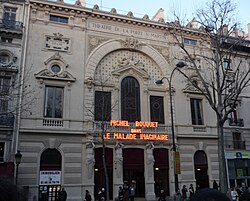Théâtre de la Porte Saint-Martin
The Théâtre de la Porte Saint-Martin is a Parisian theater hall on 16 Boulevard Saint-Martin in the 10th arrondissement of Paris . It is since 1992 listed building ( monument historique ). Originally with 1,800 seats, it was one of the largest boulevard theaters .
Alternative quarters for the Opéra
The house was supposedly built in 1781 in three months to temporarily accommodate the Paris Opera under Nicolas Lenoir, the building of which burned down before it was relocated to Rue de Richelieu in 1794. The inauguration took place on October 27, 1781. When the opera moved out, the building stood empty for several years and was used for political events. In 1799 it was sold by the state.
Boulevard theater
On September 30, 1802, the theater was opened under its current name. Spectacular pieces , comedies and ballets were played there . Pixérécourt melodramas were performed such as Robinson Crusoë in 1805. Due to the Napoleonic theater decree , it was closed in 1807 but reopened in 1810 under the name Jeux Gymniques . The license imposed severe restrictions on the theater. No more than two speaking actors were allowed on stage, all others were only tolerated as silent roles . The theater was unable to assert itself in this way and, under new management, was given a privilege in 1814 that allowed it to use its original name and again to perform melodramas : The first piece performed was La pie voleuse ( The thieving magpie by Louis-Charles Caigniez , the original to Rossini's opera La gazza ladra ).
The quality of the ballets surpassed those of the Opéra. The greatest successes were Mandrin , les Petites Danaïdes , Trente ans ou la vie d'un joueur . The mimic Charles-François Mazurier was one of the best comic dancers and made the theater one of the most popular of the time.
Romantic drama
The actors Frédérick Lemaître , Bocage, Charles-Gabriel Potier, Mademoiselle Georges and Marie Dorval made it possible to perform high-class tragedies in addition to melodramas . Frédérick Lemaître expanded the repertoire with works by Victor Hugo , Casimir Delavigne , Alexandre Dumas , Honoré de Balzac , George Sand and Victorien Sardou . The plays Marino Faliero , Antony , Richard Dartington , La Tour de Nesle , Marie Tudor , Lucrèce Borgia , the most important reform dramas of French Romanticism that had been driven out of the Comédie-Française . The theater made it possible to give the furnishings the then modern local color . An arrangement by Paul Féval's Le Bossu was performed on September 8, 1862.
The Porte Saint-Martin had to close five or six times as a result of bankruptcies, namely in 1840, 1851 and 1868. A fire in May 1870 during the Paris Commune destroyed it, but it was rebuilt in the same place and on September 28, 1873 with Marie Tudor opened by Victor Hugo.
Fin de siècle
Sarah Bernhardt bought the theater in 1883, soon sold it again, but stayed on stage until the end of the century, interrupted by her American tours. Here she played the role of Hamlet . In 1884 she celebrated a great success in the historical drama Theodora by Victorien Sardou .
Cyrano de Bergerac was premiered by Edmond Rostand on December 27, 1897 . The great success could be repeated in 1925.
20th century and present
The directorates at the beginning of the 20th century changed quickly. Stars like Fernandel appeared after the First World War, and Maurice Rostand was able to perform some of his pieces. After the Second World War, the chansonnier Max Régnier took over the theater. Hélène and Bernard Régnier have been running it since 1969 with a conservative game plan. In June 2001, Michel Sardou and Jean-Claude Camus took over the theater building, which had now been reduced to 1,000 seats and had been in the possession of the Régnier family since 1949. Michel Sardou sold his share to his partner in 2003.
literature
- André Degaine: Guide des promenades théâtrales à Paris. Nizet, Saint-Genouph 1999, ISBN 2-7078-1278-1 , pp. 107-109
- Jacques de Plunkett: Fantômes et souvenirs du "Théâtre de la Porte St Martin" 1781-1941. Paris 1946
- Gustave Vapereau : Dictionnaire universel des littératures . Hachette, Paris 1876, p. 1637
Web links
Coordinates: 48 ° 52 ′ 8.5 ″ N , 2 ° 21 ′ 24 ″ E
